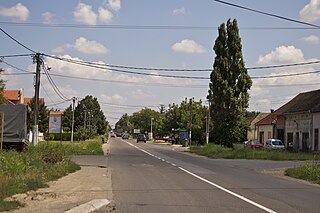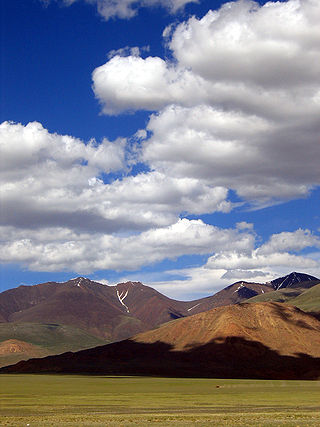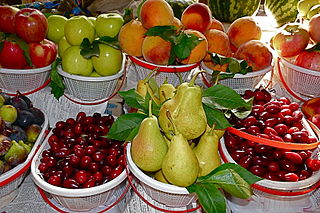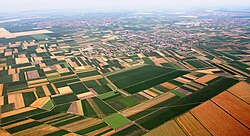
Sremski Karlovci is a town and municipality located in the South Bačka District of the autonomous province of Vojvodina, Serbia. It is situated on the banks of the Danube, 8 kilometres from Novi Sad. According to the 2011 census results, it has a population of 8,750 inhabitants. The town has traditionally been known as the seat of the Serbian Orthodox Church in the Habsburg Monarchy. It was the political and cultural capital of Serbian Vojvodina after the May Assembly and during the Revolution in 1848.

Zemun is a municipality in the city of Belgrade, Serbia. Zemun was a separate town that was absorbed into Belgrade in 1934. It lies on the right bank of the Danube river, upstream from downtown Belgrade. The development of New Belgrade in the late 20th century expanded the continuous urban area of Belgrade and merged it with Zemun.

The University of Belgrade is a public research university in Belgrade, Serbia. It is the oldest and largest modern university in Serbia.

The economy of Serbia is a service-based upper-middle income economy in the Central Europe, with the tertiary sector accounting for two-thirds of total gross domestic product (GDP). The economy functions on the principles of the free market. Nominal GDP in 2024 is projected to reach $81.873 billion, which is $12,385 per capita, while GDP based on purchasing power parity (PPP) stood at $185.014 billion, which is $27,985 per capita. The strongest sectors of Serbia's economy are energy, the automotive industry, machinery, mining, and agriculture. The country's primary industrial exports are automobiles, base metals, furniture, food processing, machinery, chemicals, sugar, tires, clothes, and pharmaceuticals. Trade plays a major role in Serbian economic output. The main trading partners are Germany, Italy, Russia, China, and neighbouring Balkan countries.

Surčin is a municipality of the city of Belgrade. As of 2022 census, it has a population of 45,452 inhabitants.

Delta Holding is a Serbian holding company with the headquarters in Belgrade. Delta Holding performs a variety of services, such as agribusiness, real estate and wholesale. It employs around 3,600 people, making it one of the largest non-government employers in the country. The founder and president of Delta Holding is Miroslav Mišković.

Ražanj is a village and municipality located in the Nišava District of southern Serbia. The municipality consists of 23 settlements having a total population of 9,150 inhabitants, with 1,245 inhabitants living in Ražanj itself. The municipality covers an area of 289 square kilometers and it is located 50 kilometers (31 mi) northwest of Niš.

Agriculture in Mongolia constitutes over 10% of Mongolia's annual gross domestic product and employs one-third of the labor force. However, the high altitude, extreme fluctuation in temperature, long winters, and low precipitation provides limited potential for agricultural development. The growing season is only 95 – 110 days. Because of Mongolia's harsh climate, it is unsuited to most cultivation.

Radmilovac is a suburban settlement of Belgrade, the capital of Serbia, and an experimental farm of the University of Belgrade's Faculty of Agriculture. It is located in the Belgrade municipality of Grocka. It is also known for the hotel of the same name.

Serbian Railways is a Serbian engineering and technical consulting company based in Belgrade, Serbia.

Little War Island or Malo ratno ostrvo or Horse Island or Konjsko ostrvo is a river island (ada) in Serbia, located at the mouth of the Sava river into the Danube. It is part of the Belgrade City proper, the capital of Serbia, and belongs to the municipality of Zemun.

Armenia has 2.1 million hectares of agricultural land, 72% of the country's land area. Most of this, however, is mountain pastures, and cultivable land is 480,000 hectares, or 16% of the country's area. In 2006, 46% of the work force was employed in agriculture, and agriculture contributed 21% of the country's GDP. In 1991 Armenia imported about 65 percent of its food.

Like the rest of the economy, agriculture in Estonia has been in great flux since the degeneration of the collective and state farm systems.
Prior to World War II, agriculture in Bulgaria was the leading sector in the Bulgarian economy. In 1939, agriculture contributed 65 percent of Net material product (NMP), and four out of every five Bulgarians were employed in agriculture. The importance and organization of Bulgarian agriculture changed drastically after the war, however. By 1958, the Bulgarian Communist Party (BCP) had collectivized a high percentage of Bulgarian farms; in the next three decades, the state used various forms of organization to improve productivity, but none succeeded. Meanwhile, private plots remained productive and often alleviated agricultural shortages during the Todor Zhivkov era.
FEFA, officially Metropolitan University - FEFA, formerly known as Faculty of Economics, Finance and Administration as a part of Singidunum University is a faculty in Novi Beograd, Belgrade, Serbia. It has been founded in 2001, and while de facto remaining independent, it was initially a member of Singidunum University and now is a member of the Metropolitan University. This higher education institution received its accreditation certificate in 2008, as first economics and management school in the country to do so under rules established by new Law on Higher Education, renewing these certificates in 2014 and 2017.

Srbijašume is a Serbian national forestry company based in Belgrade, Serbia. As of 2018, Serbia has a total of 978,283 hectares of land under forests owned by agricultural farms.
The 2019–20 Serbian First League was the 15th season of the Serbian First League since its establishment.

Agriculture in North Macedonia provides a livelihood for a fifth of the country's population, where half live in a rural area. Industrialisation of the country was very delayed, due to the long Ottoman domination, and then destruction from World War I and Serbian occupation. Massive agrarian reforms began under Socialist Federative Yugoslavia with its own communist rule. The continental and sub-Mediterranean climates in the country allows for a great diversity of output, but the pronounced terrain creates areas that are unexploitable for farmers. Macedonian agriculture is dominated by livestock farming, especially in its mountainous regions, viticulture, and the growing of fruit and vegetables, cereals, and tobacco. Agriculture in the country is characterised by numerous small-scale family farms, but also by large businesses, left over from the socialist era. Since its independence in 1991, the country has become a market economy. Today, agriculture accounts for 10% of North Macedonia's GDP.
The 2020–21 Serbian First League was the 16th season of the Serbian First League since its establishment.





















